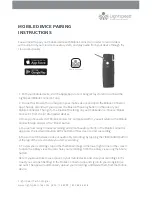
wireless signals. For enterprise users, the installation of multiple Access Points
to enlarge the coverage of wireless signals can provide wireless users with
seamless network access.
The Infrastructure mode is appropriate for enterprise-scale wireless access to a
central database or provides various wireless applications for mobile users.
Infrastructure mode also supports roaming capabilities for mobile users. More
than one BSS can be configured as an Extended Service Set (ESS). The
continuous wireless network connectivity allows users to roam freely within an
ESS. All wireless clients using WL-U357v2 or other IEEE 802.11b compliant
wireless adapters within one ESS must be configured with the same ESS ID and
to use the same radio channel.
Before adopting an ESS with roaming capability, choosing an available radio
channel with less interference is highly recommended. Proper Access Point
positioning combined with a clear radio channel will greatly enhance
performance.
Ad-Hoc
Still complaining about the high price of wireless access points? This mode is
the easiest and cost-effective way to meet your requirements. It enables you to
construct wireless networking in no time without any access point.
Ad-hoc mode is a wireless network type in which a group of computers equipped
with WL-U357v2 or other wireless adapters are connected together to form an
independent wireless LAN. All computers operating in this mode must be
configured to share the same radio channel.
In this scenario, new devices can be quickly added; however, wireless stations
can only communicate with the other peers that belong to the same IBSS
(Independent Basic Service Set).
2







































